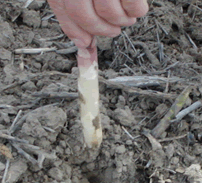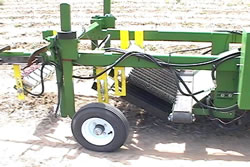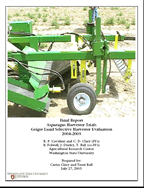Final Report Asparagus Harvester Trials Geiger Lund Selective Harvester Evaluation 2004-2005
R. P. Cavalieri and C. D. Clary (PI's)
R. Folwell, J. Durfey, T. Ball (co-PI's)
Agricultural Research Center, Washington State University
Prepared by: Carter Clary and Trent Ball
Research Summary
During the 2005 Washington asparagus harvest, a single row asparagus harvester prototype developed by Geiger Lund Harvesters, Stockton , CA was evaluated in the Pasco/Mesa area. Previous economic analysis indicated that a three row Geiger Lund harvester must recover 70% of hand harvested yield to be viable or recover 65% for a four row harvester. An evaluation was conducted to compare the selective harvester with a hand crew to analyze the machines efficiency. Eighteen rows were randomized between hand and machine treatments, with each treatment harvesting nine 1,150 foot rows. Each day, asparagus collected from each of the 18 plots was quantified and graded. The cullage, shorts and usable product were weighed. The hand harvested product and the machine usable product was then graded based on Washington fresh market standards. The total pay weight for the selective machine harvester was compared to the manual cutter to determine the efficiency of machine versus hand.
In the Pasco , 2005 trials, the selective machine harvester demonstrated the highest efficiency ever achieved compared to hand on the first day of harvesting. This was followed by a decline in efficiency in subsequent days. Typically, the machine could harvest at least 74% of a hand crew on a pay weight basis on the first day of operation. However efficiency would decline in subsequent days. This pattern of declining yield had not been seen in previous studies, suggesting variety may have an impact. Certain varieties, including the ones used in this study, tend to produce spears in tighter clusters and subject more immature spears (< 8 inches in height) to collateral damage from the blade when it cuts an adjacent 9 inch spear. Varieties that produce spears that emerge in a more spaced pattern may be more conducive to a machine harvester, such as the Jersey varieties.
The harvester's mechanical systems have been significantly improved and are now functional and reliable during longer term operation. Problems identified in the Pasco , 2005 evaluation were not found in previous trials because we could never get past the breakdowns. The declining efficiency should be the focus of additional research by Geiger Lund Harvesters, which should examine narrower blades and the effects of field conditions and asparagus varieties.
![]() Full version of paper in pdf form.
Full version of paper in pdf form.
Report in pdf format
July 27, 2005.



More pictures of the Selective Harvester may be seen at: http://www.asparagusharvester.com
Heading using the h3 tag
Lorem ipsum dolor sit amet, consectetur adipisicing elit, sed do eiusmod tempor incididunt ut labore et dolore magna aliqua. Ut enim ad minim veniam, quis nostrud exercitation ullamco laboris nisi ut aliquip ex ea commodo consequat. Duis aute irure dolor in reprehenderit in voluptate velit esse cillum dolore eu fugiat nulla pariatur. Excepteur sint occaecat cupidatat non proident, sunt in culpa qui officia deserunt mollit anim id est laborum.
